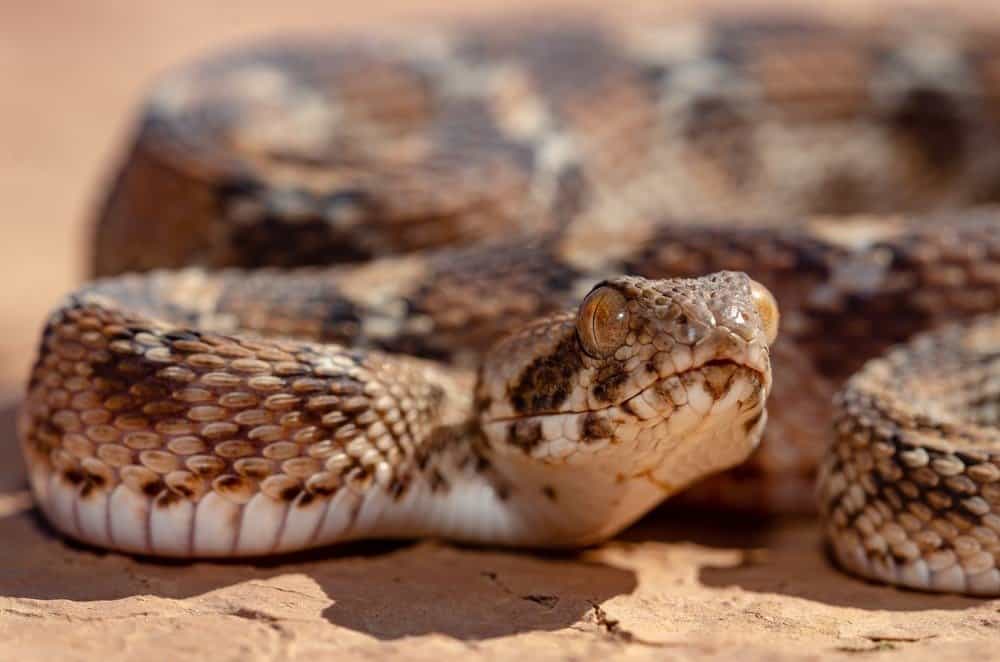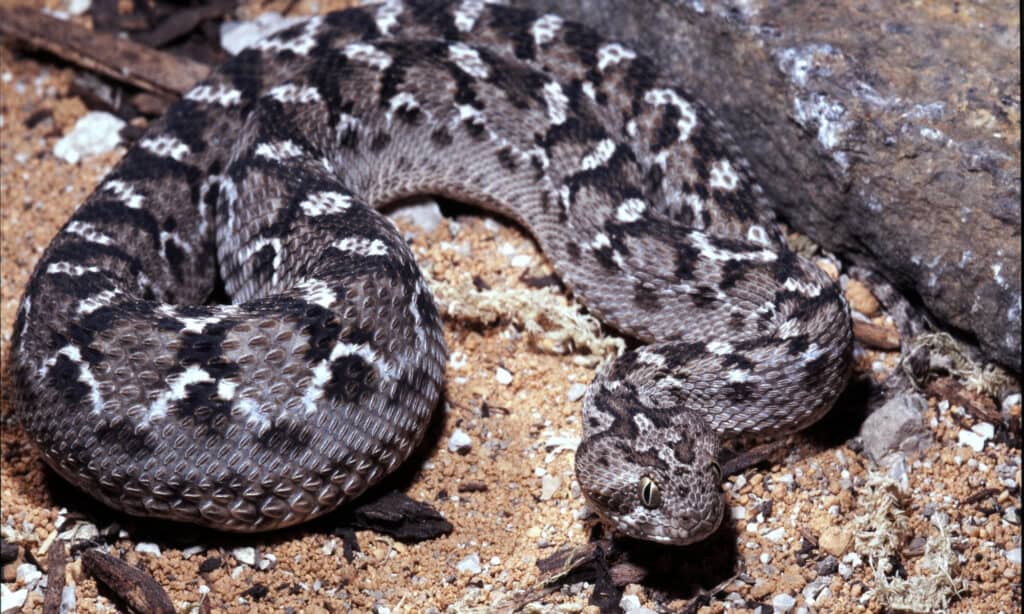Saw-scaled Viper
Echis carinatus
This is the smallest venomous snake in India's Big Four.
Advertisement
Saw-scaled Viper Scientific Classification
- Kingdom
- Animalia
- Phylum
- Chordata
- Class
- Reptilia
- Order
- Squamata
- Family
- Viperidae
- Genus
- Echis
- Scientific Name
- Echis carinatus
Read our Complete Guide to Classification of Animals.
Saw-scaled Viper Conservation Status
Saw-scaled Viper Facts
- Prey
- Rodents, lizards, frogs, scorpions, centipedes.
- Name Of Young
- Neonate or snakelet
- Group Behavior
- Solitary
- Solitary except during mating season
- Communal Dens
- Fun Fact
- This is the smallest venomous snake in India's Big Four.
- Estimated Population Size
- Widespread.
- Biggest Threat
- Habitat loss
- Most Distinctive Feature
- Strongly keeled scales, very rough in appearance.
- Gestation Period
- 5 months
- Average Litter Size
- 15
- Lifestyle
- Nocturnal/Crepuscular
- Number Of Species
- -1
Saw-scaled Viper Physical Characteristics
- Color
- Brown
- Grey
- Fawn
- Black
- White
- Cream
- White-Brown
- Skin Type
- Scales
- Lifespan
- Approximately 12 years
- Length
- Up to 31 inches
- Age of Sexual Maturity
- Approximately 2-3 years.
- Venomous
- Yes
- Aggression
- Medium
View all of the Saw-scaled Viper images!
Saw-scaled vipers are highly venomous snakes that are endemic to most of Asia and India.
These small vipers only reach about two feet long in most cases, but their venom is extremely toxic. They are one of the species responsible for most snakebites in their native range, and their venom is the subject of medical research.
Incredible Saw-scaled Viper Facts
- Saw-scaled vipers are the smallest of the big four snakes responsible for the most snakebites on the Indian subcontinent.
- These snakes move by sidewinding. It’s a frighteningly quick travel method that only allows two points of contact with the ground.
- Several anticoagulant drugs are manufactured using their venom.

Scientific Name And Classification
Saw-scaled vipers are in the Viperidae subfamily of Viperinae, one of the true vipers. Their scientific name is Echis carinatus and roughly translates to keeled viper. Echis is Greek for viper, and carinatus has its root in Latin for keel. It refers to the strongly-keeled scales all over the body of these serpents.
In the languages of its various localities, this species goes by several names, including vali polonga in Sinhala, Dhuli Naga in Odia, and phissi in Pushtu.
Evolution And History
It is believed that snakes first originated around 128 million years ago on the ancient supercontinent Laurasia, in the warm, environments of the Southern Hemisphere. They are able to live in a wide variety of habitats, showing incredible diversity. Because of their shared anatomy, it is known that snakes evolved from lizards.
Types Of Saw-Scaled Viper
There are a total of 11 species of saw-scaled vipers. Including the nominate subspecies, Echis carinatus carinatus, there are five subspecies of Saw-scaled viper, and all live in different regions.
12 Species:
- Roman’s saw-scaled viper (Echis romani)
- Egyptian saw-scaled viper (Echis pyramidum)
- Oman saw-scaled viper (Echis omanensis)
- Painted saw-scaled viper (Echis coloratus)
- Hughes’ saw-scaled viper (Echis hughesi)
- Joger’s saw-scaled viper (Echis jogeri)
- African saw-scaled viper (Echis ocellatus)
- Cherlin saw-scaled viper (Echis megaloce)
- White-bellied carpet viper (Echis leucogaster)
- Khosatzk ’s saw-scaled viper (Echis khosatzkii)
5 Subspecies:
- Astola saw-scaled viper (E. c. astolae)
- South Indian saw-scaled viper (E. c. carinatus)
- Multiscale saw-scaled viper (E. c. multisquamatus)
- Sri Lankan saw-scaled viper (E. c. sinhaleyus)
- Sochurek’s saw-scaled viper (E. c. sochureki)
Appearance

The Saw scaled Viper has a rough skin texture that doesn’t reflect light which helps to conceal itself.
©Luis Montero de Espinosa/Shutterstock.com
The saw-scaled viper has a large head that’s distinct from its neck, its snout is rounded and very short. Its head is covered with small scales that are keeled, and it has elliptical pupils.
This is a short, stout snake that can measure between 15 and 31 inches in length but usually doesn’t exceed 24 inches. Its dorsal scales are keeled and have pits at the tips of each, and along its sides, the keeled scales are serrated. This viper has a rough skin texture that doesn’t reflect much light, helping it conceal itself more effectively.
Its base color can be grayish, reddish, pale tan, olive, or brown, which is overlaid with mostly whitish spots that have dark brown edges which are separated by lighter patches. On top of its head is often a whitish trident-type pattern and an indefinite stripe from the eye to the jaw. It has a whitish-to-pinkish belly that may have brown dots.

Saw-scaled vipers have large eyes set close to their nose.
©reptiles4all/Shutterstock.com
Behavior
While there have been a few reports of these snakes being active during the day, they are mostly nocturnal or crepuscular. They hide in abandoned burrows, rock crevices, and fallen logs. However, if they live in a sandy habitat, they may bury themselves and only leave their head visible.
Saw-scaled vipers are most active on humid nights and evenings or after it rains, yet, they don’t want to be in the water. When it rains, up to 80% of the adult population finds its way into bushes and trees, and there have been reports of up to 20 individuals gathered on a small shrub or cactus. They are primarily terrestrial. However, many are found climbing in bushes, and up cacti, sometimes up to nine feet off the ground.
They may migrate locally to hibernacula to ride out the winter in a group den but don’t seem to migrate overly long distances.
Habitat And Diet
These snakes mostly occur in sandy, desert areas. However, saw-scaled vipers are versatile, and the only thing they seem to avoid is an overly marshy area. They’re equally at home in forests, shrubs, grassland, rocky areas like cliffs and mountain peaks, as well as in deserts. As adaptable as it is, this species really prefers areas where the soil is soft and sandy, with dry scrub and grassland.
Saw-scaled vipers eat a vast array of critters, including rodents, lizards, frogs, scorpions, centipedes, and large insects. Their diet varies according to what’s available, and they are willing to eat whatever they can swallow.
Predators, Threats, And Conservation

Birds of prey and mongooses often prey on venomous snakes.
©Vladislav T. Jirousek/Shutterstock.com
Natural predators of these young and even mature snakes are fairly limited. However, birds of prey in many areas and larger carnivores like mongooses often prey on venomous snakes.
Saw-scaled vipers have no major threats to their population as a whole. However, locals may kill them on sight. These snakes are widespread throughout their native range. In some areas, habitat loss and/or over-collection for venom extraction may be threats. Yet, at this point, the IUCN doesn’t believe that any special action is needed to protect them and lists them as Least Concern on the IUCN Redlist of Threatened Species.
Reproduction, Babies, And Lifespan
This species generally mate in the winter, and females give birth to a litter of up to 23 snakelets from April through August. Saw-scaled vipers are usually mature by about three years of age and, on average, live about 12 years.
Venom
These highly venomous snakes are one of the big four. Saw-scaled vipers are the smallest of the four species, which also include the Indian cobra (Naja naja), Russel’s viper (Daboia russelii), and the common krait (Bungarus caeruleus). These four species are responsible for the most snakebite deaths, and one reason is that all of these snakes occur in highly populated areas.
About 20% of untreated victims perish, so immediate care is vital, and saw-scaled viper venom is lethal at only 5mg. Yet, these snakes can inject as much as 12mg in a single bite. When bitten, a person experiences local pain and swelling, but that’s not what kills. Their venom causes hemorrhaging and coagulation defects, where the blood doesn’t clot properly. Nosebleeds, bloody urine or stools, and coughing up blood are very common and sometimes lead to hypovolemic shock, a state where the body has an abnormally low amount of fluids. Almost all victims develop hypouresis (lack of urine), and some require kidney dialysis.
Dangers of envenomation aside, antivenom is generally available and works well in most cases. Deaths after envenomation by the saw-scaled viper are rare because treatment is readily available. There are several antivenins available for this species’ venom; combined with intravenous hydration, survival chances are quite high.
Venom In Medicine

Saw-scaled vipers are crucial to medicine as their toxin is used for various pharmaceuticals.
©reptiles4all/Shutterstock.com
Like the venom from other snakes, including the golden lancehead, saw-scale viper venom is very important in medicine. Pharmaceutical companies make several drugs using either purified whole venom or synthetic venom. The toxin that they’re primarily focused on with saw-scaled vipers is echistatin, an anticoagulant. It’s one of the toxins that make bite victims bleed out. The advantage to using this toxin for medicines is that its structure is very simple, making it easy to synthesize.
Here are a few drugs:
- Ecarin – it’s used as the primary reagent in the ECT (ecarin clotting time) test.
- Aggrastat – an antiplatelet medication sometimes used in cases of myocardial infarction or ischemia.
Research using viper venom, not just this species, is ongoing. There are bound to be more medical breakthroughs and medications thanks to this research which doesn’t hurt the snake.
Similar Animals
- Saw-scaled vipers are a type of carpet viper. They’re small, highly venomous snakes endemic to much of Asia.
- The horned viper gets around town the same way that saw-scaled vipers do – by sidewinding.
- Nose-horned vipers are aggressive and quick to bite.
Saw-scaled Viper FAQs (Frequently Asked Questions)
Are saw-scaled vipers venomous?
Yes they are! Their venom is fatal at about 5mg in a bite, yet they can inject up to 12mg in a single bite.
Where do saw-scaled vipers live?
All across Asia, including the Indian subcontinent. They’re a common venomous snake.
What do saw-scaled vipers eat?
These are generalists that are also small in stature. So, they eat whatever they can bite and swallow, which can include scorpions, centipedes, frogs, lizards, and rodents.
Are saw-scaled vipers aggressive?
They’re said to be cranky and irritable, making a bite from one more likely.
Is saw-scaled viper venom used in medicine?
Yes, several venomous species’ venom has found their way into medical research. The venom from this species is used in making anticoagulants. The toxin, echistatin, is both potent and simple in chemical structure.
Thank you for reading! Have some feedback for us? Contact the AZ Animals editorial team.
Sources
- Carpet Viper | IUCN Redlist of Threatened Species, Available here: https://www.iucnredlist.org/species/164694/1068235
- Medical Dictionary, Available here: https://medical-dictionary.thefreedictionary.com/Echis+carinatus+carinatus
- Echis carinatus | Reptile Database, Available here: https://reptile-database.reptarium.cz/species?genus=Echis&species=carinatus
- Echis carinatus | Wikipedia, Available here: https://en.wikipedia.org/wiki/Echis_carinatus

















